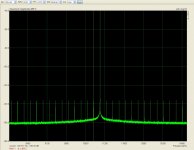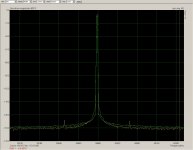And rightly so.
You still have my number? I'll be playing with this tomorrow unless John decides that he doesn't want me to do the basic measurements after all. Bring over whatever DAC you like.
Let's leave the DAC argument alone for now, at least.
Yes bring over a DAC & have at least a second opinion! I presume some listening will be done & not just measurements?
SY, I presume you will also post your SPDIF waveform scope shots?
Sy,
So far You had shown RMAA loopback tests with your dacs.
Looping back means that the dac / adc are using the same master clock, and even extremely high jitter in this master clock is eliminated in the process.
I have seen it many times before.
Please, try to do the same thing by simply cross-linking them: audiofire to M-audio or vica versa. Or any external very low distortion generator would do it.
Ciao, George
Please show me in the spectra of noise and distortion where my DAC is "crap." Noise, distortion, and freedom from jitter-induced sidebands are impeccable.
So far You had shown RMAA loopback tests with your dacs.
Looping back means that the dac / adc are using the same master clock, and even extremely high jitter in this master clock is eliminated in the process.
I have seen it many times before.
Please, try to do the same thing by simply cross-linking them: audiofire to M-audio or vica versa. Or any external very low distortion generator would do it.
Ciao, George
So, let’s sum up the good news.
After endless bitching on my part we are finally going to get what we should have had from jkeny before he ever started touting his RF attenuator mod.; a documented test, although not a test of the attenuator mod.
jkeny has revealed the equipment with which the result can be obtained:
ThorstenL has agreed a technical standard:
This is particularly good news for me, as the Emu 1616M is well within my price range, and I’ve fancied one for a while.
He’s even been good enough to state acceptable conditions for a blind test.
And Joseph K, having replied in this fashion:
Is deemed to accept the technical standard set down by ThorstenL.
Not only that, tomorrow, hopefully, we get a perfectly good report from SY which I for one will not dispute if it shows an effect.
w
After endless bitching on my part we are finally going to get what we should have had from jkeny before he ever started touting his RF attenuator mod.; a documented test, although not a test of the attenuator mod.
jkeny has revealed the equipment with which the result can be obtained:
Reviews were done using PASS D1 DIY DAC, Buffalo DAC, Audiosector NOS DAC, Audio-gd DAC19 DSP, PS Audio PerfectWave DAC
End-users have used a wide range of DACS - some listed here: Hegel HD 10 DAC, Chevron Audio Paradox 8i dac, Beresford 7520 DAC, Abrahamsen V6 DAC, lots more to list.
I have used various implementations of the Sabre DACs - the Buffalo & AckoDAC
ThorstenL has agreed a technical standard:
Folks, as a POST SCRIPVM,
I would probably recommend using a Manufacturers eval board with documented jitter performance (e.g. the Cirrus Logic CS4398 demo fixture) and using a non ASRC based receiver for measuring the analogue output.
If an AP2 is too hard to come by, some external sound cards have converters with reasonable resolution and their clock systems can be modified (stock not very good) to allow reasonably low levels of jitter to be measured (still not patch on an AP2, but it will serve), the EMU1616M is one example.
As said, my view on listening tests with a small N is that they are statistically speaking completely non-significant, so I would probably not bother. The minimum I accept for "good enough for internal use" has an N of around 50 and at least three experienced listeners...
Ciao T
This is particularly good news for me, as the Emu 1616M is well within my price range, and I’ve fancied one for a while.
He’s even been good enough to state acceptable conditions for a blind test.
And Joseph K, having replied in this fashion:
Sy,
So far You had shown RMAA loopback tests with your dacs.
Looping back means that the dac / adc are using the same master clock, and even extremely high jitter in this master clock is eliminated in the process.
I have seen it many times before.
Please, try to do the same thing by simply cross-linking them: audiofire to M-audio or vica versa. Or any external very low distortion generator would do it.
Ciao, George
Is deemed to accept the technical standard set down by ThorstenL.
Not only that, tomorrow, hopefully, we get a perfectly good report from SY which I for one will not dispute if it shows an effect.
w
Van Morrison said:You can take
All the tea in China
Put it in a big brown bag for me
Sail right round
The Seven Oceans
Drop it straight
Into the deep blue sea…
BTW, a big hug & kisses to Jocko - I know you're looking in - I owe you more than I can ever say - how could I have gotten where I am today without you - you made me whole  - keep in touch, you know it's good to talk
- keep in touch, you know it's good to talk  !!!
!!!
 - keep in touch, you know it's good to talk
- keep in touch, you know it's good to talk  !!!
!!!Please, try to do the same thing by simply cross-linking them: audiofire to M-audio or vica versa. Or any external very low distortion generator would do it.
Good idea, I'd like to see that. And I'd go further. See if you can mess up the spdif signal. Run it thru zip line, or unterminated, near a transformer or SMPS or something. Would be interesting to see if the FFT shows anything.
Waki, I just want to say I hang on your every post. They are always interesting, contribute greatly to the community here - no matter what level they are at. Please please post even more in this and other threads.
Sy: really looking forward to the results and impressions.
Can I ask a question of you guys? Can any harm be done by putting in one of the attenuators? Like physical damage?
Fran
Sy: really looking forward to the results and impressions.
Can I ask a question of you guys? Can any harm be done by putting in one of the attenuators? Like physical damage?
Fran
This was another shot at it, emu spdif out > sabre spdif in > sabre analog out > emu in. A very close closein. Yellow is the sabre, green is EMU1616.
After this I gave up because was not satisfied by the test's "resolutive power". All this quite some time ago.
After this I gave up because was not satisfied by the test's "resolutive power". All this quite some time ago.
Attachments
Last edited:
Do you have comparatives at the same frequency, same resolution, same level, same window, same sample rate...? The lines spaced ~180Hz apart on the loopback spectrum look suspicious. As do some of the lineshapes.
Nonetheless, all of the artifacts are at ridiculously low levels.
Nonetheless, all of the artifacts are at ridiculously low levels.
Ok, thank you George.
I agree with you Waki: I think we should now have a new moderation, even legal policy that no-one can mention or describe a mod to any equipment unless they have documented, measured proof that it works. Listening casually should be met with ridicule, possibly should be a matter for criminal prosecution.
Funny how I bought my attenuators from minicircuits.com. A casual browse online seems to suggest they are a reasonably large multinational company, based in the US, although with UK distributors (the people I dealt with). I did ask them what it was like working for this irish guy jkeny, and the sales rep just sighed. What did he mean by that?
After endless bitching on my part we are finally going to get what we should have had from jkeny before he ever started touting his RF attenuator mod.; a documented test, although not a test of the attenuator mod.
I agree with you Waki: I think we should now have a new moderation, even legal policy that no-one can mention or describe a mod to any equipment unless they have documented, measured proof that it works. Listening casually should be met with ridicule, possibly should be a matter for criminal prosecution.
Funny how I bought my attenuators from minicircuits.com. A casual browse online seems to suggest they are a reasonably large multinational company, based in the US, although with UK distributors (the people I dealt with). I did ask them what it was like working for this irish guy jkeny, and the sales rep just sighed. What did he mean by that?
Last edited:
Sy,
Those "spuries" are the jitter test signal itself.
11025 Hz -6db + ~229Hz LSB signal toggled.
The second shot shows a "comparative" measurement: one is loopback, the other is accross the external dac. They are overlayed. The signal used was not a JT test signal that time, just a sinusoidal. The lineshapes are due to the bmp/jpeg conversion - zooming in the originals, they are fine.
EDIT: I withdraw this last. the 229 Hz line variations are real, artifacts.
Those "spuries" are the jitter test signal itself.
11025 Hz -6db + ~229Hz LSB signal toggled.
The second shot shows a "comparative" measurement: one is loopback, the other is accross the external dac. They are overlayed. The signal used was not a JT test signal that time, just a sinusoidal. The lineshapes are due to the bmp/jpeg conversion - zooming in the originals, they are fine.
EDIT: I withdraw this last. the 229 Hz line variations are real, artifacts.
Last edited:
😀 As I said before Jocko & other Trolls will never get past the security gates of my 400 acre estate on Maui - doh!, I was supposed to keep that summer home secret!
Last edited:
Here there are two players. Pardon, I could not crop better. They are the same setup anyway.
These were done with the same conditions like the EMU feedback loop.
These were done with the same conditions like the EMU feedback loop.
Attachments
Last edited:
And finally, for fun, a really good dac.
If it's such a good DAC, why all the spurs? The ones I use don't seem to have that problem. Is this the analogy to the high distortion, marginally stable amp which sells for $50k and is praised for being "especially revealing of cable differences"?
- Status
- Not open for further replies.
- Home
- Source & Line
- Digital Source
- RF Attenuators = Jitter Reducers





 OT posts removed.
OT posts removed.